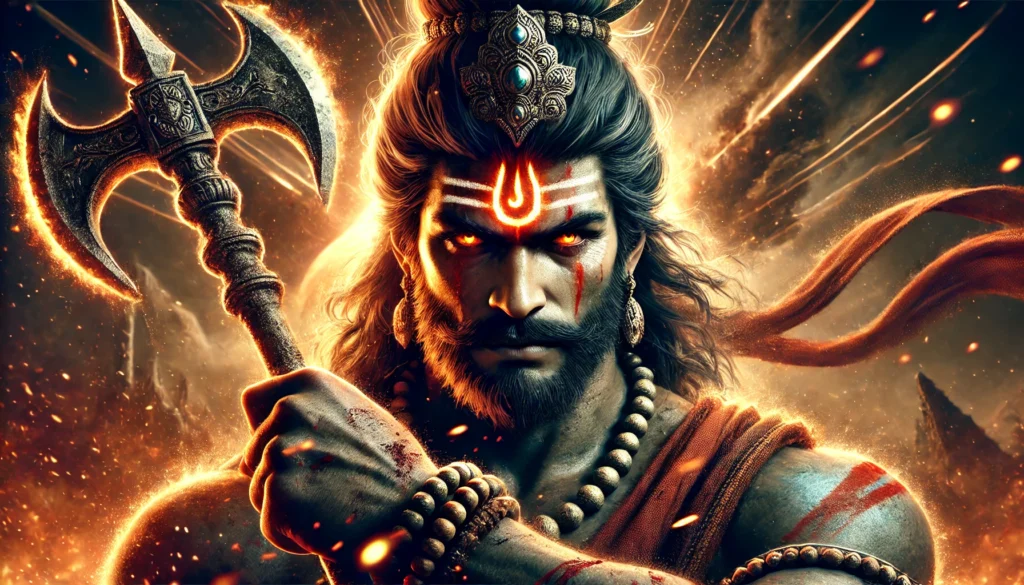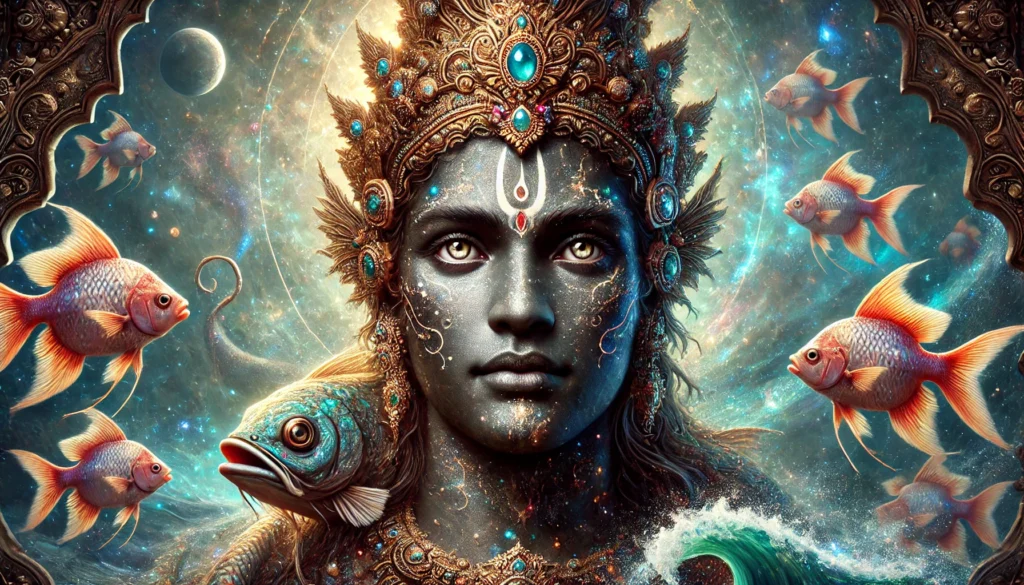Introduction: The Eternal Guardian of Dharma
In the vast tapestry of Hindu mythology, Lord Vishnu stands as the preserver of the universe, safeguarding cosmic order (Dharma) through his ten divine incarnations known as the Dashavatara. These avatars represent Vishnu’s commitment to protecting the world from chaos, injustice, and unrighteousness. Each avatar, from the primal fish to the prophesied warrior of the future, embodies a profound lesson, offering guidance to humanity across ages.
The Dashavatara tales capture the timeless struggle between good and evil, highlighting Vishnu’s dynamic role in upholding harmony. As the Bhagavad Gita declares:
“Paritranaya sadhunam vinasaya cha duskritam, dharma-samsthapanarthaya sambhavami yuge yuge”
(“To protect the virtuous, destroy the wicked, and establish Dharma, I manifest in every age.”)
This article explores the Vishnu avatars, their unique stories, and the universal messages they convey.

The Dashavatara: Vishnu’s Ten Incarnations
The Dashavatara represents Vishnu’s descent into the mortal realm to restore balance. Each incarnation correlates with a critical juncture in time, ensuring the preservation of life and cosmic principles. Let’s journey through these mythology stories and unravel the Vishnu avatar story behind each form.
1. Matsya: The Fish Avatar
The first avatar, Matsya, symbolizes the preservation of knowledge and the beginning of creation. Appearing as a giant fish, Matsya warned King Manu of an impending deluge that would engulf the world. Matsya helped Manu save seeds of life, sacred scriptures, and living beings by guiding an ark through the floodwaters.

- Lesson: Matsya underscores the importance of foresight, preservation of wisdom, and the interconnectedness of life.
- Scriptural Reference: The story is recounted in the Shatapatha Brahmana and the Matsya Purana.
2. Kurma: The Tortoise Avatar
When the gods and demons sought the nectar of immortality (amrita), the cosmic ocean needed to be churned. Vishnu assumed the form of Kurma, a giant tortoise, to support Mount Mandara as a churning rod.
- Lesson: Kurma teaches the value of patience, balance, and collaboration in overcoming challenges.
- Dashavatara Power: His unyielding shell symbolizes steadfastness amidst turmoil.
- Scriptural Reference: The Vishnu Purana describes the churning of the ocean, known as Samudra Manthan.
3. Varaha: The Boar Avatar
To rescue the Earth goddess (Bhoomi Devi) from the demon Hiranyaksha, Vishnu incarnated as Varaha, a powerful boar. He dived into the cosmic ocean, defeated the demon, and lifted the Earth back to its rightful place.
- Lesson: Varaha emphasizes the triumph of divine intervention in restoring order.
- Symbolism: The boar’s strength reflects resilience in the face of overwhelming darkness.
4. Narasimha: The Lion-Man Avatar
Perhaps the most ferocious of Vishnu’s avatars, Narasimha was born to destroy the tyrannical demon king Hiranyakashipu. Neither man nor beast, Narasimha emerged from a pillar to honor the boon protecting the demon from death by conventional means.
- Lesson: Narasimha illustrates that arrogance and tyranny cannot stand before the divine.
- Mythology Stories in English: The vivid tale captures Vishnu’s adaptability in upholding Dharma.
- Scriptural Reference: Found in the Bhagavata Purana.
5. Vamana: The Dwarf Avatar
Vamana, the diminutive sage, appeared during the reign of Bali, a benevolent yet ambitious demon king. To curb Bali’s growing power, Vamana requested three paces of land. Expanding to cosmic proportions, Vamana covered the Earth, heavens, and netherworld in two strides, humbling Bali.
- Lesson: Humility and self-restraint triumph over pride.
- Vishnu Mythology: Vamana highlights how wisdom can outshine sheer strength.

6. Parashurama: The Warrior with the Axe
Born as a Brahmin with the ferocity of a Kshatriya, Parashurama wielded an axe gifted by Shiva. He rid the world of corrupt Kshatriya rulers, restoring balance and justice.
- Lesson: Parashurama’s story reflects the cyclical nature of power and its accountability to Dharma.
- Dashavatara Power: His martial skills and unwavering discipline symbolize the forceful protection of righteousness.
7. Rama: The Ideal King
The seventh avatar, Rama, embodies the epitome of virtue, honor, and duty. Known for his unwavering commitment to Dharma, Rama’s story is chronicled in the Ramayana. From his exile to the epic battle with Ravana, Rama’s life showcases the struggles of upholding moral integrity in challenging circumstances.
- Lesson: Rama emphasizes the importance of selflessness, leadership, and adherence to principles.
- Scriptural Reference: The Ramayana is a timeless epic narrating his journey.
8. Krishna: The Divine Statesman
As the eighth avatar, Krishna is celebrated for his wisdom, charisma, and divine playfulness. From his childhood adventures in Vrindavan to his role as Arjuna’s charioteer in the Mahabharata, Krishna epitomizes the art of living with purpose.
- Key Teachings: His guidance in the Bhagavad Gita explores profound philosophical truths about life, duty, and spirituality.
- Dashavatara Power: Krishna’s adaptability and strategic acumen symbolize his divine mastery.
Quote:“Yada yada hi dharmasya glanir bhavati Bharata…” (“Whenever Dharma declines, I manifest myself.”)
9. Buddha: The Enlightened One
In a surprising twist, the ninth avatar, Buddha, represents compassion and non-violence. By renouncing worldly attachments, Buddha guided humanity toward enlightenment and inner peace. This incarnation reflects Vishnu’s recognition of the need for spiritual awakening during a period of moral decay.
- Lesson: Buddha underscores the power of introspection, compassion, and detachment from materialism.
- Vishnu Avatar Story: Some interpretations see Buddha as a reformer who opposed ritualistic practices in Hinduism.
10. Kalki: The Future Avatar and the Prophecy
The final avatar, Kalki, is yet to appear. Prophecies describe Kalki as a warrior riding a white horse, wielding a blazing sword to destroy evil and restore Dharma. His arrival marks the end of Kali Yuga, the age of darkness.
- Lesson: Kalki symbolizes hope and the ultimate triumph of good over evil.
- Kalki Prophecy: According to the Vishnu Purana, Kalki will appear when the world is consumed by greed, corruption, and spiritual degradation.
FAQs About Vishnu Avatars
1. What is the significance of Dashavatara in Hindu mythology?
The Dashavatara illustrates Vishnu’s evolving role as the preserver of cosmic balance, adapting to the needs of different epochs.
2. How do the avatars relate to the concept of Dharma?
Each avatar represents Vishnu’s intervention to restore Dharma, guiding humanity toward righteousness.
3. When will Kalki Avatar appear?
According to the Vishnu Purana, Kalki will appear at the end of Kali Yuga to restore cosmic harmony.
4. Why is Buddha considered an avatar of Vishnu?
Buddha is regarded as an avatar who emphasized non-violence and moral reform during a period of ritual excess.
5. How does Dashavatara align with evolution?
Some scholars draw parallels between Dashavatara and the evolution of life, from aquatic beings (Matsya) to advanced humans (Krishna and Kalki).
Conclusion: Vishnu’s Legacy and Relevance Today
The 10 avatars of Vishnu are not just mythological tales but timeless narratives that reflect humanity’s perpetual quest for balance, justice, and spiritual growth. The Dashavatara continues to inspire, offering profound lessons on leadership, humility, and perseverance. In a world grappling with chaos, these stories remind us of the eternal promise that, in every age of darkness, light shall emerge to restore harmony.

Pingback: Indrajit: The Unsung Warrior Who Defeated the Gods - Vedic Wars
Pingback: When Will Kali Yuga End? Discover Vedic Secrets Today - Vedic Wars